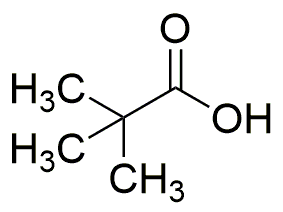Pivalic acid is widely utilized in research focused on:
- Pharmaceuticals: It serves as a building block in the synthesis of various drugs, enhancing their stability and bioavailability. For example, it is used in the production of certain anti-inflammatory medications.
- Food Industry: Pivalic acid acts as a food additive, providing flavoring and preservation benefits. Its unique properties help in extending the shelf life of certain food products.
- Polymer Chemistry: This compound is employed in the manufacture of specialty polymers and resins, which are crucial for creating durable materials used in coatings and adhesives.
- Agricultural Chemicals: It is involved in the formulation of herbicides and pesticides, improving their effectiveness and reducing environmental impact compared to traditional compounds.
- Laboratory Reagents: Pivalic acid is a valuable reagent in organic synthesis, enabling researchers to create complex molecules more efficiently, thus saving time and resources in the lab.
General Information
Properties
Safety and Regulations
Applications
Pivalic acid is widely utilized in research focused on:
- Pharmaceuticals: It serves as a building block in the synthesis of various drugs, enhancing their stability and bioavailability. For example, it is used in the production of certain anti-inflammatory medications.
- Food Industry: Pivalic acid acts as a food additive, providing flavoring and preservation benefits. Its unique properties help in extending the shelf life of certain food products.
- Polymer Chemistry: This compound is employed in the manufacture of specialty polymers and resins, which are crucial for creating durable materials used in coatings and adhesives.
- Agricultural Chemicals: It is involved in the formulation of herbicides and pesticides, improving their effectiveness and reducing environmental impact compared to traditional compounds.
- Laboratory Reagents: Pivalic acid is a valuable reagent in organic synthesis, enabling researchers to create complex molecules more efficiently, thus saving time and resources in the lab.
Documents
Safety Data Sheets (SDS)
The SDS provides comprehensive safety information on handling, storage, and disposal of the product.
Product Specification (PS)
The PS provides a comprehensive breakdown of the product’s properties, including chemical composition, physical state, purity, and storage requirements. It also details acceptable quality ranges and the product's intended applications.
Certificates of Analysis (COA)
Search for Certificates of Analysis (COA) by entering the products Lot Number. Lot and Batch Numbers can be found on a product’s label following the words ‘Lot’ or ‘Batch’.
Numéro de catalogue
Numéro de lot/série
Certificates Of Origin (COO)
This COO confirms the country where the product was manufactured, and also details the materials and components used in it and whether it is derived from natural, synthetic, or other specific sources. This certificate may be required for customs, trade, and regulatory compliance.
Numéro de catalogue
Numéro de lot/série
Safety Data Sheets (SDS)
The SDS provides comprehensive safety information on handling, storage, and disposal of the product.
DownloadProduct Specification (PS)
The PS provides a comprehensive breakdown of the product’s properties, including chemical composition, physical state, purity, and storage requirements. It also details acceptable quality ranges and the product's intended applications.
DownloadCertificates of Analysis (COA)
Search for Certificates of Analysis (COA) by entering the products Lot Number. Lot and Batch Numbers can be found on a product’s label following the words ‘Lot’ or ‘Batch’.
Numéro de catalogue
Numéro de lot/série
Certificates Of Origin (COO)
This COO confirms the country where the product was manufactured, and also details the materials and components used in it and whether it is derived from natural, synthetic, or other specific sources. This certificate may be required for customs, trade, and regulatory compliance.


